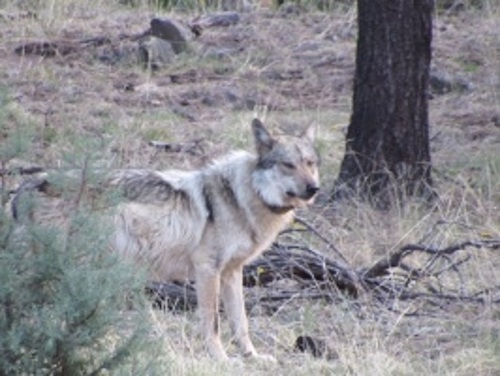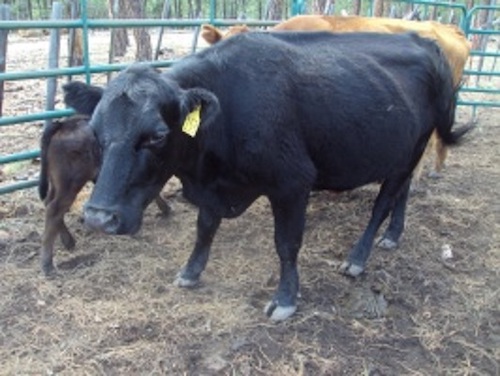The Chronicles Of Grant County
Mexican Wolves
Part Two
Depredations Of Livestock – Catron County
 A Mexican wolf is seen west of Luna in northwestern Catron County, New Mexico. "The wolf was carrying a beef calf's head in its mouth," stated Jess Carey, Catron County Wildlife Investigator. "If you look to the right of the wolf's left front foot there is the calf's head it dropped to pose for photo." (Photograph was provided courtesy of Jess Carey, Catron County Wildlife Investigator, April 24, 2107.)
A Mexican wolf is seen west of Luna in northwestern Catron County, New Mexico. "The wolf was carrying a beef calf's head in its mouth," stated Jess Carey, Catron County Wildlife Investigator. "If you look to the right of the wolf's left front foot there is the calf's head it dropped to pose for photo." (Photograph was provided courtesy of Jess Carey, Catron County Wildlife Investigator, April 24, 2107.)
Nature can be wonderful to experience.
Nature can also be quite cruel in practice.
It's important to understand the distinctions of how wild animals survive. Some only eat grass, while some only eat certain types of plants. Some animals eat other animals. Still others eat just about anything – plant or animal. A few are scavengers – only eating animals that have already died. These dead animals can include ones left by other animals that killed their prey for food, animals that have been hit by motor vehicles, and animals that have died due to natural causes.
Most animals that survive by eating other animals first kill their prey, then they consume the animals. Bears and mountain lions in the area typically kill smaller animals first, then eat them.
Wolves – and coyotes as well – do not typically follow this pattern.
"Wolves and coyotes kill by consumption," stated Jess Carey, Catron County Wildlife Investigator.
You heard that correctly: Wolves and coyotes will generally kill their prey while eating the prey while it's still alive.
"A wolf will typically pick out an animal – whether it be an elk or a cow – for some reason," Mr. Carey explained. "It may be an animal away from others in its group. For whatever reason chosen, the wolf will then chase the animal and bite at its legs, its flank, its shoulders, or other parts of its body. The bites are not usually massive bites, but they help the wolf bring the prey down. The chase and biting will continue until its prey is exhausted. Cattle typically cannot handle a pursuit that goes on for a long time. Once the prey – say a cow – lays down, the wolf will start feeding on the animal."
"I can't say definitely how or if wolves target pregnant cows, but there does seem to be a pattern to some of the kills," said Mr. Carey. "With a pregnant cow, a wolf will rip the unborn calf from the mother and consume that calf."
Mr. Carey explained that once a livestock animal is down and the wolf had its fill, coyotes will oftentimes come and eat remaining sections of the animal. "Coyotes do not typically kill cattle on their own, but coyotes will sometimes follow wolves as kills are made," Mr. Carey continued. "Ravens, eagles, and vultures then come in to finish the animal off," Mr. Carey continued. "While some hide and bones might remain, the carcass is usually cleaned in a short time period. A 400-pound cow can be effectively gone within two days."
While coyotes generally do not kill most types of livestock, there is one type they seem to target. "Coyotes will kill new-born calves – usually during the first three days of life," stated Mr. Carey.
Most wolf attacks occur at night, Mr. Carey noted, but there some daytime kills when the barometric pressure changes as storms approach the region. The animal attacked may die quickly or the death may be slow from blood loss, for example, he explained. While most livestock attacked by wolves die from the attack and subsequent feeding, Mr. Carey stated that not all livestock die from these situations.
"Some livestock are able to get up after the initial attack and feeding by a wolf," said Mr. Carey. "An animal may sometimes end up some distance away from the site of wolf attack. When survivors are found, the animals are almost always put down. They are usually in pain and cannot survive the types of wounds inflicted by a wolf attack and feeding."
Mr. Carey has been the Wildlife Inspector for Catron County since April of 2006. He was the sheriff in that County in 1985-1986 as well as the County's undersheriff for four other years. During his time as Wildlife Inspector, Mr. Carey estimated that he has investigated more than 950 predator/animal interactions within Catron County as well as more than 250 wolf/human interactions within county limits. "The investigative techniques used in this work are similar to the processes used in law enforcement," stated Mr. Carey. "You cannot confirm a wolf depredation based on circumstantial evidence. You have to be able to confirm that an injury or death has occurred through teeth marks, wolf tracks, and other direct evidence. You have to document that evidence through photographs and reports."
In early June, The Chronicles Of Grant County will detail the specific number of livestock killed by wolves – and other predator animals – in Catron County since 2017.
Future news columns will focus on specific aspects of the impact of the wolves being reintroduced into New Mexico by the Federal Government. Catron County is home to more than 95% of the wolves in the state, according to Mr. Carey. The activities in Catron County, located just north of Grant County, directly impact people in Grant County as wolves do not recognize county boundaries.
Information will be included in future news columns from those who support the efforts to reintroduce wolves into New Mexico and Arizona, from those that manage operations for this program, and from those local folks who are impacted by the reintroduction of wolves. Among those local folks will be home owners, ranchers, school officials, and other governmental officials as well as representatives of tourism, real estate, and other business interests in the region. In addition, information will be included on how other states are handling wolf reintroduction programs in their territories.
 "This photograph shows cows and calves in a holding pen, typical on all ranches in our area," stated Mr. Carey. (Photograph was provided courtesy of Jess Carey, Catron County Wildlife Investigator, July 2, 2016.)
"This photograph shows cows and calves in a holding pen, typical on all ranches in our area," stated Mr. Carey. (Photograph was provided courtesy of Jess Carey, Catron County Wildlife Investigator, July 2, 2016.)
Do you have questions about communities in Grant County?
A street name? A building?
Your questions may be used in a future news column.
Contact Richard McDonough at chroniclesofgrantcounty@mail.com.
If your email does not go through, please contact editor@grantcountybeat.com.
© 2021 Richard McDonough


